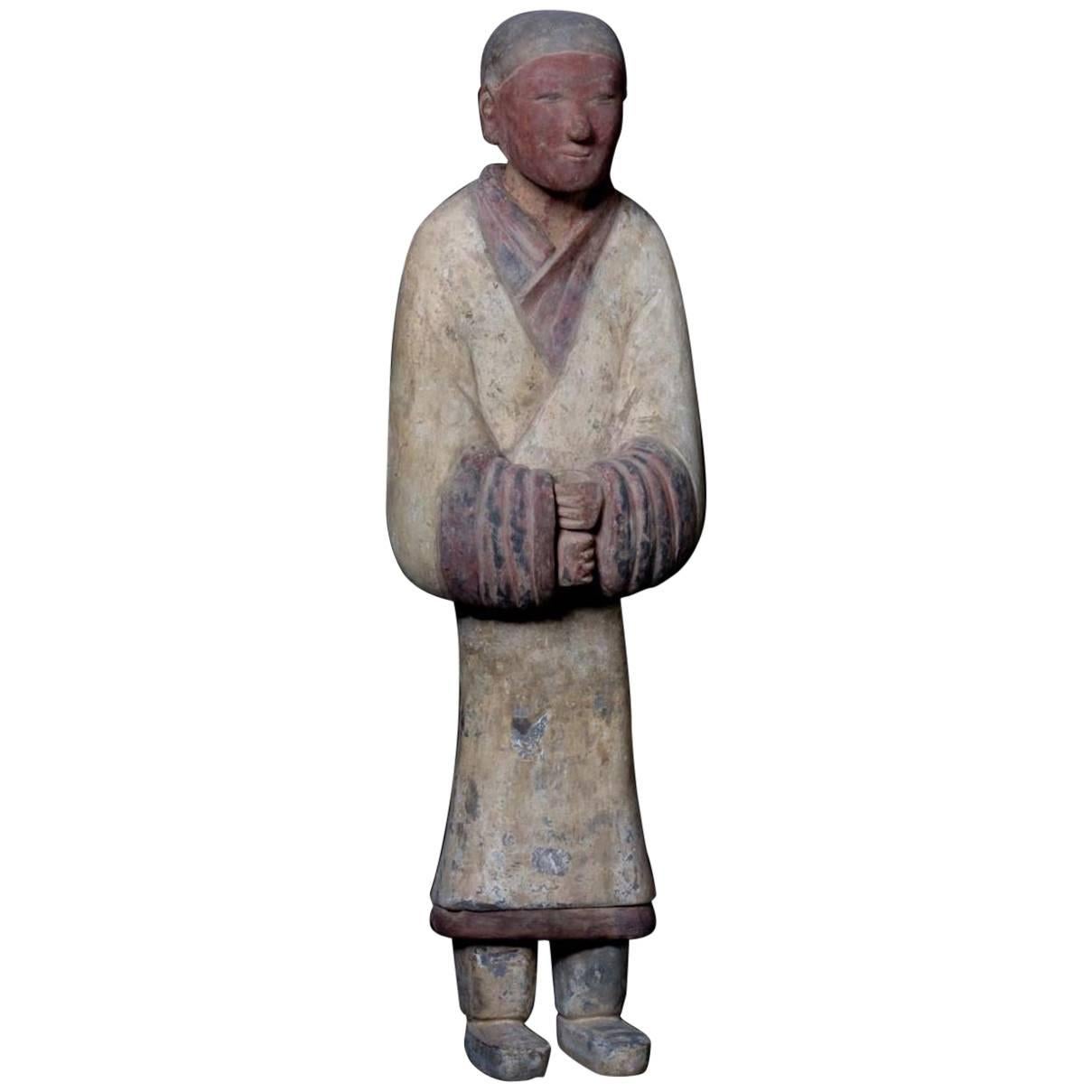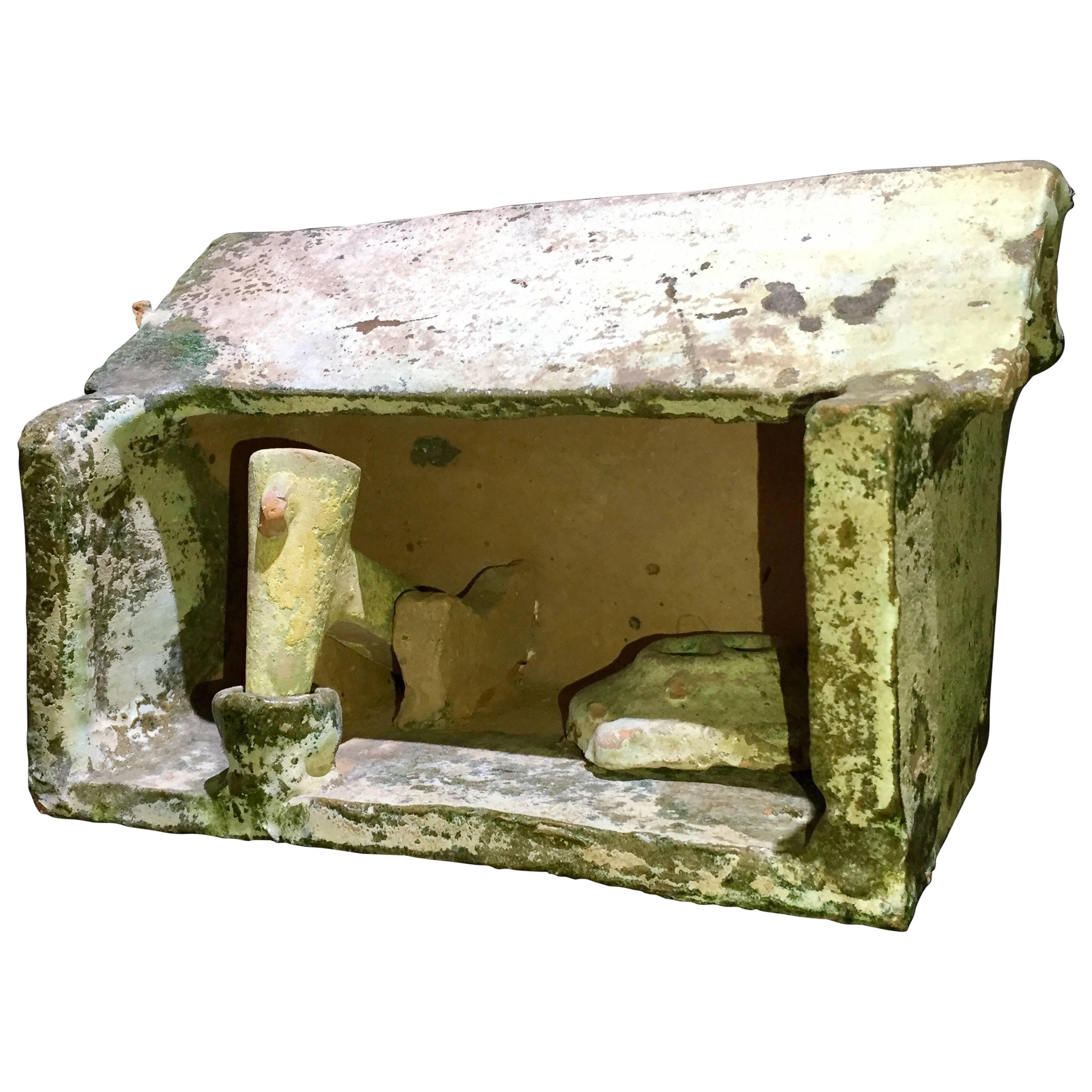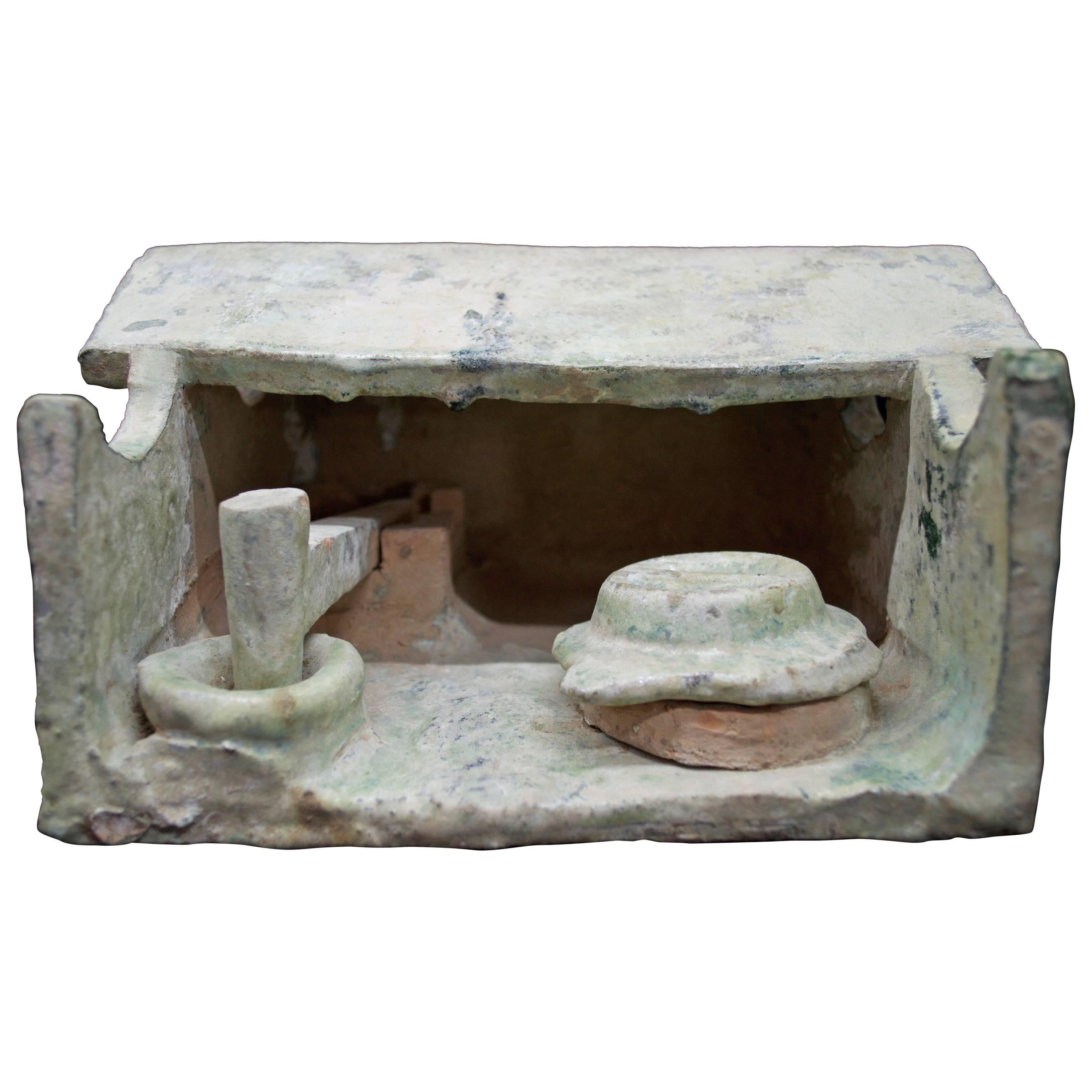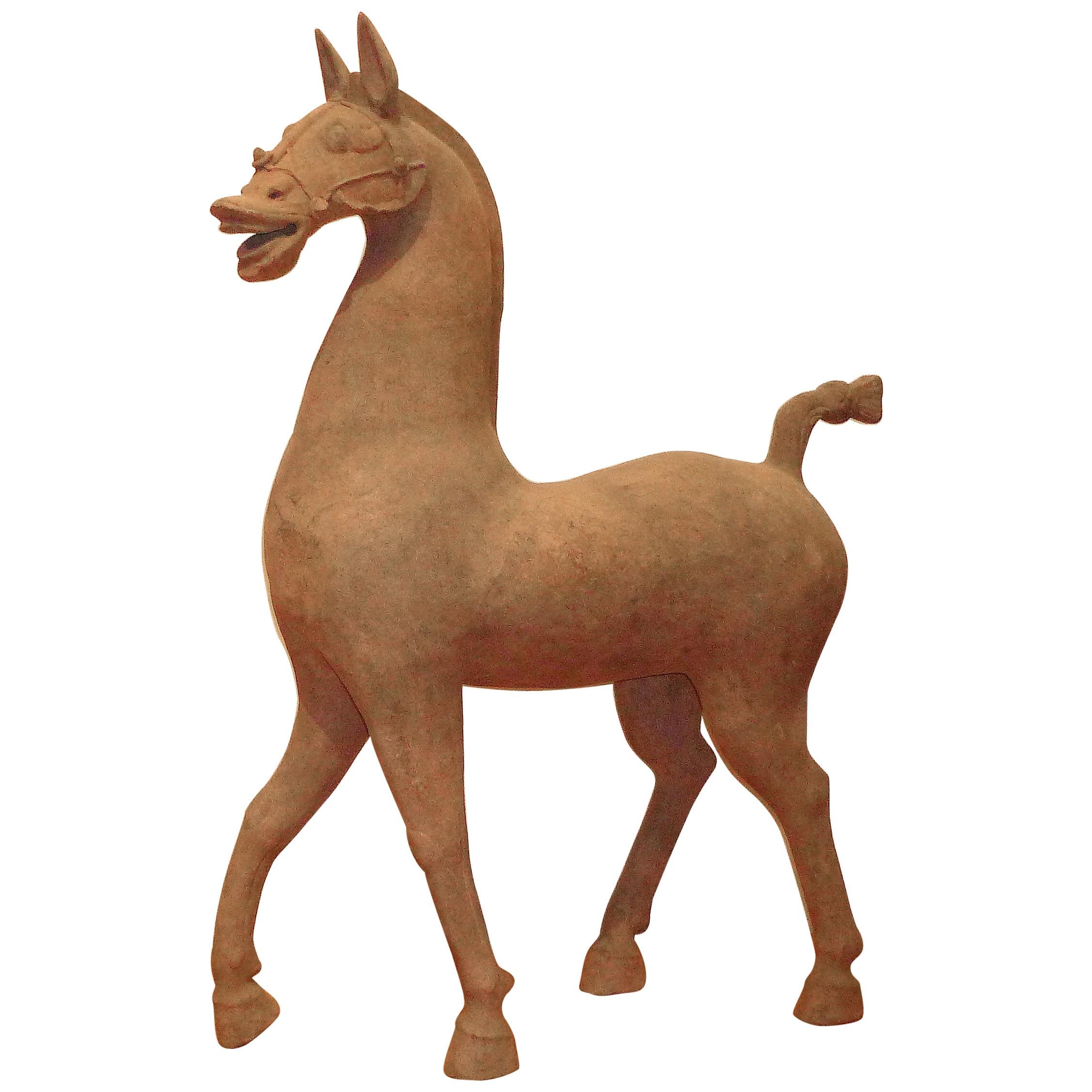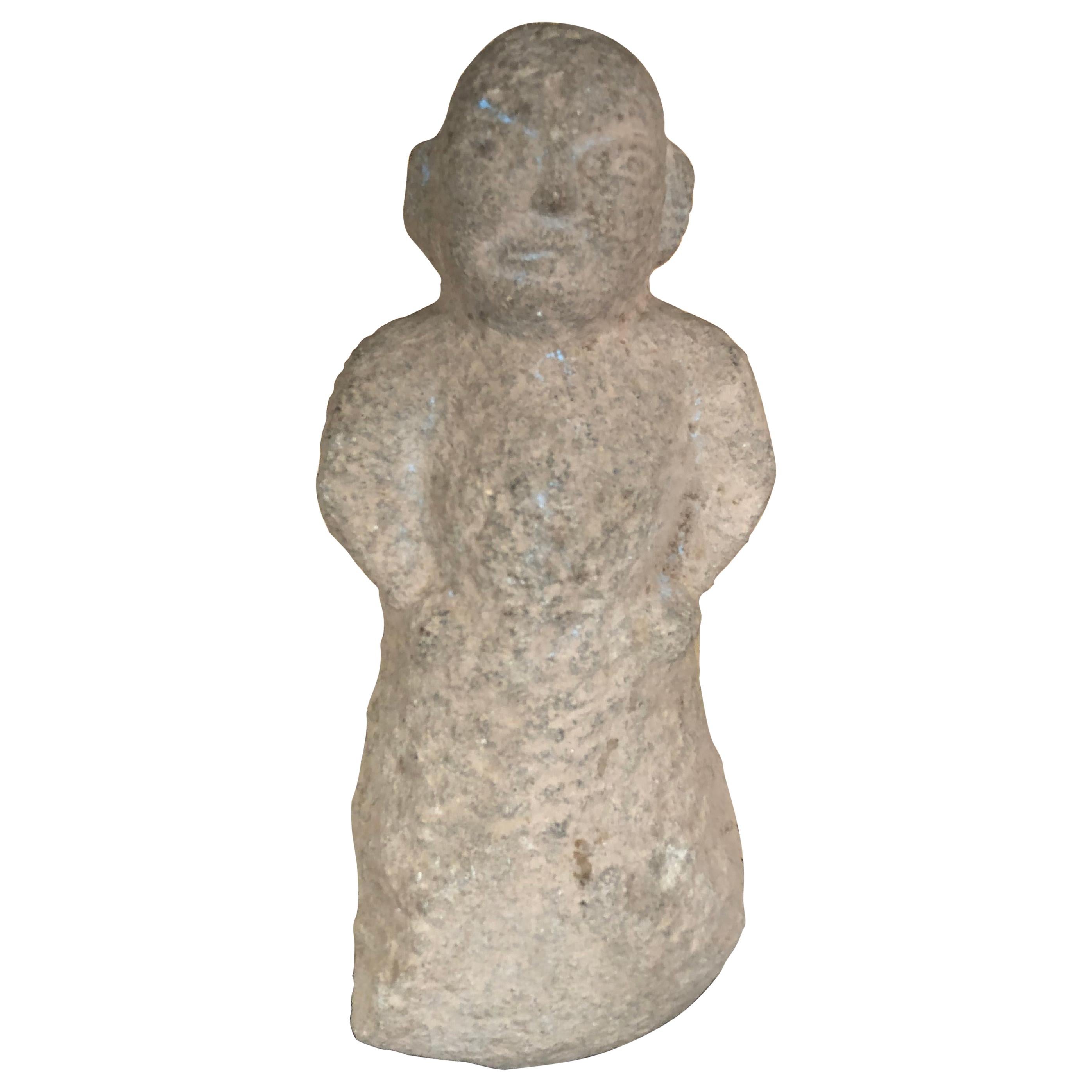Items Similar to Monumental Han Dynasty Terracotta Horse - TL Tested - China, '206 BC–220 AD'
Want more images or videos?
Request additional images or videos from the seller
1 of 10
Monumental Han Dynasty Terracotta Horse - TL Tested - China, '206 BC–220 AD'
About the Item
A massive pottery horse with separately made head and tail, standing on all fours and striding with its right hoof forward. Extended snout ends in parted lips showing teeth beneath in a braying attitude. Low relief bridle on face and well defined eyes. Raised mane down back of the neck. Reassembled from mostly large fragments with restoration over the break-lines and some new fill. A fantastic example of the Han Dynasty Horse, during this period the prized horse came from the Ferghama Valley in Central Asia, now Afghanistan.
Large, exquisite walking Ferghana horses with great attention paid to anatomical detail were the choice of the wealthy. The horse was second only in importance to the dragon. It was supposed to possess magical powers which the early Chinese were eager to explore. It would be the horse that would carry the deceased to the next life and it would be the amount of horses that an individual owned that would guarantee his ongoing status in the hereafter.
Impressive Museum Masterpiece. Private NYC Collection.
Thermoluminescence certificate from Oxford Labs included.
The Han dynasty was the second imperial dynasty of China (206 BC–220 AD), preceded by the Qin dynasty (221–206 BC).
Spanning over four centuries, the Han period is considered a Golden Age in Chinese history. To this day, China's majority ethnic group refers to themselves as the "Han people”.
The emperor was at the pinnacle of Han society. He presided over the Han government but shared power with both the nobility and appointed ministers who came largely from the scholarly gentry class.
Around the turn of the millennium, Han tomb architectural styles morphed from pits into multi-chambered underground dwellings, often with elaborate carvings and wall paintings. Many shrines in turn were covered with low-relief carvings depicting paradises and stories underscoring Confucian virtues like filial piety and loyalty.
The shrines and spirit paths became an important way for the living to proclaim the deceased family member’s and their own commitment to Confucian values.
Ultimately, funerary objects such as mingqi worked in concert with other funerary objects, tomb architecture, shrines, and spirit-road sculptures to achieve a goal that exceeded the well-being of the family.
According to Confucian doctrine, when every person performed their prescribed social role to perfection, the cosmos would achieve harmony. By ensuring the well-being of the dead, the living promoted accord in the celestial realm and in their own terrestrial existence.
- Dimensions:Height: 43 in (109.22 cm)Width: 37 in (93.98 cm)Depth: 12 in (30.48 cm)
- Style:Han (Of the Period)
- Materials and Techniques:
- Place of Origin:
- Period:
- Date of Manufacture:206 BC-220 AD
- Condition:Wear consistent with age and use. Reassembled from mostly large fragments with restoration over the break-lines and some new fill.
- Seller Location:San Pedro Garza Garcia, MX
- Reference Number:
About the Seller
3.7
Vetted Seller
These experienced sellers undergo a comprehensive evaluation by our team of in-house experts.
1stDibs seller since 2017
22 sales on 1stDibs
- ShippingRetrieving quote...Ships From: San Pedro Garza Garcia, Mexico
- Return PolicyA return for this item may be initiated within 3 days of delivery.
More From This SellerView All
- Elegant Han Dynasty Terracotta Warrior - China '206 BC - 220 AD'Located in San Pedro Garza Garcia, Nuevo LeonImpressive terracotta warrior representing a banner bearer gripping a wooden staff with his hands (dematerialized through the ages); his gaze is ser...Category
Antique 15th Century and Earlier Chinese Han Antiquities
MaterialsTerracotta
- Eastern Han Dynasty Terracotta Model of a Paper Mill , China '206BC - 220AD'Located in San Pedro Garza Garcia, Nuevo LeonSlab pottery constructed Model of a Paper Mill, in Green and Cream Color Glazed Terracotta having a peaked roof – open walled form with a mechanical pounder and a large round storage container. Light blue-green mottled glazed surface with some iridescence patina to the glaze. The Iridescence is a refraction of the layers on the glass that produces multicolor hues & metallic luster, and only develops after one thousand years of being buried in the ground. An unquestionable mark of antiquity, impossible to falsify. Han Dynasty, dated 206 B.C-220 A.D. Condition: Excellent, wear commensurate with age, an unusual example. This fantastic piece is accompanied by a Certificate of Authenticity. Sculptural effigies of domesticated animals were often interred in the tombs of nobility and elite members of the social hierarchy. Models like this one were made to represent everything from simple goat or pig pens to the most elaborate towers and palaces. Because very few ancient Chinese buildings have survived intact, these models, along with descriptions from ancient texts, give a good representation of what the buildings might have looked like. Burial figurines of graceful dancers, mystical beasts, and everyday objects reveal both how people in early China approached death and how they lived. Since people viewed the afterlife as an extension of worldly life, these figurines, called mingqi, sometimes referred as “spirit utensils” or “vessels of ghosts” disclose details of routine existence and provide insights into belief systems over a thousand-year period. For the first time in Chinese history, we have images of rural and daily life during the Han in the form of contemporary records...Category
Antique 15th Century and Earlier Chinese Han Antiquities
MaterialsTerracotta
- Eastern Han Dynasty Terracotta Barn Workshop, China '206BC - 220AD' Ex-MuseumLocated in San Pedro Garza Garcia, Nuevo LeonSlab pottery constructed barn workshop having a peaked roof – open walled form with a mechanical pounder and a large round covered storage container. Light blue-green mottled glazed surface with some iridescence patina to the glaze. Condition: Intact, excellent condition, an unusual example. Provenance: The Living Torah Museum, Brooklyn; ex. Sands of Time, 2002. Sculptural effigies of domesticated animals were often interred in the tombs of nobility and elite members of the social hierarchy. Models like this one were made to represent everything from simple goat or pig pens to the most elaborate towers and palaces. Because very few ancient Chinese buildings have survived intact, these models, along with descriptions from ancient texts, give a good representation of what the buildings might have looked like. This fantastic piece is accompanied by a Certificate of Authenticity. Burial figurines of graceful dancers, mystical beasts, and everyday objects reveal both how people in early China approached death and how they lived. Since people viewed the afterlife as an extension of worldly life, these figurines, called mingqi, sometimes referred as “spirit utensils” or “vessels of ghosts” disclose details of routine existence and provide insights into belief systems over a thousand-year period. For the first time in Chinese history, we have images of rural and daily life during the Han in the form of contemporary...Category
Antique 15th Century and Earlier Chinese Han Antiquities
MaterialsTerracotta
- Stunning Terracotta Standing Horse, Tang Dynasty, China '618-907 AD', TL TestLocated in San Pedro Garza Garcia, Nuevo LeonMagnificent standing horse in orange terracotta and traces of painting. With a finely decorated saddle and with the mane and tail hair braided. TL Test by Ralph Kotalla Lab NE: 09K12...Category
Antique 15th Century and Earlier Chinese Tang Antiquities
MaterialsTerracotta
- Majestic Prancing Horse, Tang Dynasty, China '618-907 AD', TL Test by KotallaLocated in San Pedro Garza Garcia, Nuevo LeonMagnificent prancing horse in orange terracotta with traces of polychrome paint. Springing its right leg with a lively position and an expressive look. With a finely decorated saddle...Category
Antique 15th Century and Earlier Chinese Tang Antiquities
MaterialsTerracotta
- Magnificent Court Attendants in Terracotta - Ming Dynasty, China 1368-1644 AD TLLocated in San Pedro Garza Garcia, Nuevo LeonA magnificent pair of male and female courtiers from the Ming Dynasty (1368-1644 CE) in excellent condition. They are wearing traditional Daopao robes in green and black garments wit...Category
Antique 15th Century and Earlier Chinese Ming Antiquities
MaterialsTerracotta
You May Also Like
- Ancient China Monumental Stone Ram Han Dynasty, 206BC-220ADLocated in South Burlington, VTChina, a large votive model of a stone ram, Han dynasty (206BC-220AD) Dimensions: 45cm, 18 inches high and 65cm, 26 inches length and 25cm, 10 inches wi...Category
Antique 15th Century and Earlier Chinese Han Sculptures and Carvings
MaterialsLimestone
- Massive Chinese Han Dynasty Sichuan Terracotta Pottery Horse, Oxford TL TestedLocated in Greenwich, CTA massive Chinese Han dynasty Sichuan terracotta pottery figure of a horse Han dynasty (206 BC-220 AD) Powerfully modelled in a pose of alert attention, its strong neck and head po...Category
Antique 15th Century and Earlier Chinese Han Sculptures and Carvings
MaterialsTerracotta
- Chinese Ancient Stone Male Figure, 206 BC-220 ADLocated in South Burlington, VTChina, a rare hand carved stone male figure from the Han dynasty (206 BCE-220 CE). Dimensions: 16 inches tall on its custom stand and and 6 inches wide Condition: old patina wi...Category
Antique 15th Century and Earlier Chinese Han Sculptures and Carvings
MaterialsTerracotta
- Green-glazed pottery lampstand, Han Dynasty(206BC-220AD)Located in seoul, KRThe upper section of the vessel is broad and flat, intended to support a candle or an oil lamp, while the stem and base are robust, designed for stability and durability. The surface...Category
Antique 15th Century and Earlier Chinese Han Antiquities
MaterialsEarthenware
- A Large Han Dynasty (206BC-220AD) Glazed Hu VesselLocated in Chicago, ILThis is a fine example of a Han hu wine storage vessel, buried for the afterlife. The compressed globular body narrows sharply to a slender waisted neck, covered with a dark green le...Category
Antique 15th Century and Earlier Chinese Han Antiquities
MaterialsTerracotta
- Pair of Red Sculpture Han Dynasty Gray Pottery Horse Heads '206BC-220AD'Located in Miami, FLPair of Chinese Han dynasty horse heads Han dynasty Style (206 BC-220 AD) earthenware gray pottery Each approximate measures: 6 inches high. 6...Category
Mid-20th Century Chinese Han Sculptures and Carvings
MaterialsTerracotta
